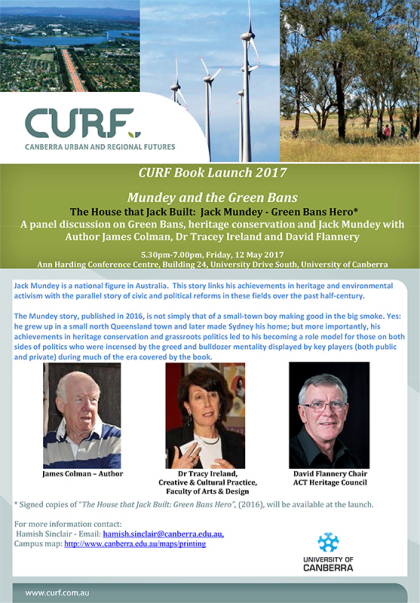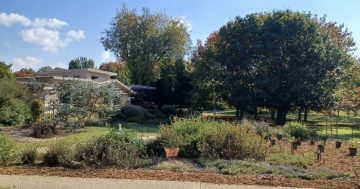
This Friday, 12 May, Canberra Urban and Regional Futures (CURF) is holding a book launch and panel discussion about the biography The House that Jack Built: Jack Mundey – Green Bans Hero, by James Colman.
I picked up and read this biography back in January, when I visited the Demolished Sydney exhibition at the Sydney Museum. The biography tells the story of Jack Mundey, the union leader and urban hero of the 1970s who used ‘green bans’ to save many heritage buildings and precincts, such as the Rocks, that Sydney residents and countless tourists enjoy today.
Mundey and his biographer, urban planner Jim Colman (the latter will be at the book launch), are alarmed at the re-emergence now of planning and development trends that led to a community uprising and ‘green bans’ in the 1970s.
The green bans arose from a realization by Mundey and the union he led, the NSW Branch of the Builders Labourers’ Federation (BLF), that there was little point making money on a construction job if you were at the same time destroying your cultural inheritance, your landmark buildings and your community precincts.
The BLF agreed that they would place green bans on building sites where they were asked to intervene by the public. Mundey would speak with the locals. If at an open public meeting a formal resolution involving members of the affected community was passed seeking union support, the union would seek endorsement by its rank and file and then impose a green ban. Then Mundey would sit down, talk it over again with stakeholders, and negotiate.
What are some of the lessons from the 1970s green bans for Canberra in the second decade of the 21st century?
The first lesson is the need for constant vigilance. If the community is not alert and engaged, our heritage may disappear before our eyes for short-term commercial gain by a few developers and revenue gain by government.
The second lesson is that protection of the “commons” (community land and resources belonging to or affecting the whole community), unites diverse groups opposed to their destruction or sale for private gain.
The third lesson, related to the second, is that there is massive strength from building alliances across community groups and other stakeholders. These alliances help to counter attacks that protesters are a few ‘NIMBYs’ or ‘silver tails’ who don’t like change. Such attacks were levelled at people in the 1970s who protested the destruction of important heritage buildings or precincts. It is a classic put-down and divide-and-rule tactic.
The fourth essential lesson is the importance of genuine community participation in planning. Before making decisions affecting people, government must engage with those in the neighbourhood, other local residents, and workers, and others “in the line of fire”.
Question: Do you think that in the 21st century, unions would be likely to join with residents to save heritage sites?
Details for the book launch:
When: 5.30pm-7.00pm, Friday, 12 May 2017
Where: Ann Harding Conference Centre, Building 24, University Drive South, University of Canberra
Registration: Free – email hamish.sinclair@canberra.edu.au
Marea Fatseas
Former independent candidate for the seat of Kurrajong in 2016 ACT elections













